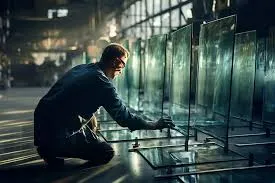The glass industry, long associated with age-old craftsmanship, has undergone a substantial transformation over the years. Thanks to advancements in technology, the manufacturing process is becoming smarter, more efficient, and environmentally conscious. From automation to precision engineering, modern techniques are reshaping the way glass is produced while maintaining its core attributes of transparency, durability, and versatility.
Automation in Glass Manufacturing
Automation has introduced a wave of innovation in glass production, automating tasks that were once labor-intensive. Robots and advanced machinery now handle everything from raw material handling to quality inspections, significantly cutting down on manual intervention. Automated systems enable consistent production rates and ensure that even delicate glassware is produced with precision.
For example, computer-controlled machines can regulate furnace temperatures with pinpoint accuracy. This eliminates the human error that often leads to discrepancies in glass quality. Additionally, automated conveyor systems streamline the moving and shaping processes, reducing waste and improving production timelines.
Workers are no longer required to perform repetitive tasks. Instead, they can oversee operations and focus on high-level problem solving. Automation not only improves output but also contributes to safer working conditions across manufacturing plants.
The Role of Precision Engineering
Precision engineering has been a game-changer when it comes to creating intricate or highly customized glass items. Advances in technology allow manufacturers to implement cutting-edge techniques, such as computer-aided design (CAD) and laser cutting. These tools make it possible to produce glass objects with remarkable accuracy, down to the smallest measurement.
One of the most notable innovations in this field is the implementation of 3D printing technologies in glass production. Initially limited to prototyping and design development, 3D printing is now capable of creating fully functional glass components. This level of accuracy ensures fewer defects and greatly reduces scrap materials, which is a win for both producers and customers.
The integration of high-performance materials, like alumina, into glass composites has also improved durability and strength. Alumina aids in achieving higher resistance to temperature and wear, making it a preferred addition to specialized glass products.
Focusing on Sustainability
With global emphasis on reducing environmental footprints, sustainable practices have become a pivotal aspect of modern glass manufacturing. Traditional methods of production often rely on energy-intensive processes, contributing to significant carbon emissions. However, new technologies are aimed at making glass production more eco-friendly without compromising quality.
Recycling has become a key focus. Used glass, also known as cullet, can now be efficiently melted down and repurposed into new products. This not only cuts down on waste but also saves energy, as melting cullet requires significantly lower temperatures compared to raw material processing.
Energy-efficient furnaces, powered by renewable sources like electricity generated from wind or solar energy, are also coming to the forefront. Additionally, advanced filtration systems are reducing harmful emissions from manufacturing plants, enabling the sector to align with stricter environmental regulations.
Enhanced Quality Control
The incorporation of sensors and smart technologies is revolutionizing how manufacturers monitor and ensure quality in glass production. High-resolution cameras and artificial intelligence (AI) systems are now capable of detecting even the tiniest imperfections on glass surfaces. These technologies can identify defects that were previously invisible to the human eye, ensuring a consistently superior product.
Real-time monitoring systems help manufacturers adjust production parameters instantly, reducing the occurrence of flawed batches. These innovations not only enhance the quality of products but also minimize material wastage during production. Over time, this leads to cost savings and greater customer satisfaction.
Digital Transformation in Design Processes
Another area where technology has left its mark is in the design phase. Traditionally, the design and mold-making process took weeks, if not months, to finalize. Today, software tools allow designers to work collaboratively and make adjustments instantly. Virtual simulations make it easier to test the feasibility of designs before production, saving both time and resources.
Augmented reality (AR) and virtual reality (VR) technologies are also being adopted to visualize glass prototypes in a 3D space. This approach makes it easier for clients and manufacturers to identify potential improvements early on and helps in creating bespoke products tailored to unique needs.
The Future of Glass Manufacturing
Looking ahead, the glass manufacturing sector is poised for even more innovation. Autonomous systems, better algorithms, and smarter materials will become pivotal in advancing the industry further. There’s a growing interest in smart glass—adaptive glass that can change its properties, such as opacity or temperature control, based on environmental conditions. These products are expected to see increasing demand across sectors like construction and automotive.
One thing is evident: as technology continues to evolve, the production of glass is becoming faster, greener, and smarter. These advancements not only meet rising consumer demand but also align with global goals for sustainability and efficiency.
Final Thoughts
Technology has truly revolutionized glass manufacturing, breathing new life into an ancient craft. From automation and precision engineering to sustainable practices, these innovations are driving the industry toward a more streamlined, cost-effective, and environmentally friendly future. Glass, a seemingly straightforward material, continues to adapt and thrive in an era where technology reshapes industries across the globe.




